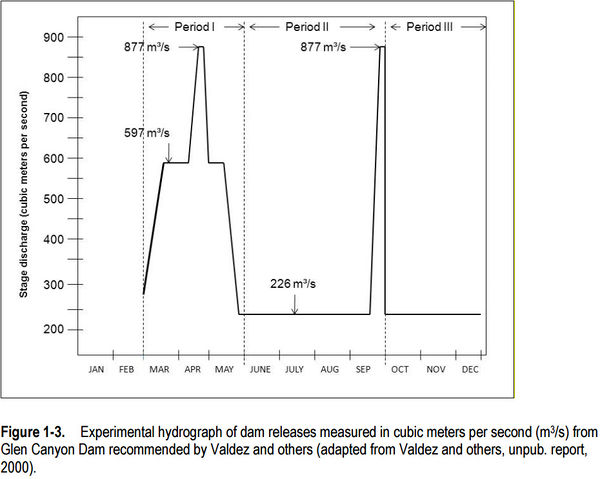Description of the Low Summer Flow Experiment
|
|
Low summer flows (minimum daily mean 5,000 to 8,000 cfs) for three months (Jul.–Sep.) to target ≥14°C at Little Colorado River confluence.
The experiment would not be conducted if:
- Release temperatures were too low to reach 14°C at Little Colorado River confluence even with going to a minimum flow of 5,000 to 8,000 cfs, or
- Release temperature were predicted to be high enough in July, August, or September to reach 14°C at Little Colorado River confluence under normal operations.
|
Objectives
|
|
Increase humpback chub growth
|
Trigger
|
|
Initial experiment: in the second 10 years of the LTEMP period (2026-2036) when target temperature of ≥14°C can be achieved only with low summer flow
Subsequent experimental use if:
- Initial test was successful,
- Humpback chub population concerns warrant their use,
- Water temperature appears to be limiting recruitment, and
- Target temperature of ≥14°C could be achieved only with low summer flow.
|
Offramps
|
- Low summer flows do not increase growth and recruitment of humpback chub
- Increase in warmwater nonnative species or trout at the Little Colorado River
- Longterm unacceptable adverse impacts on the resources listed in Section 1.3 are observed, or
- Sufficient warming does not occur as predicted
|
Costs and Risks
|
- Reduced food availability to humpback chub by
- desiccating the nearshore environment with the reduction in flow between June and July, and
- reducing drift with the reduction in daily fluctuation.
- Increased bioenergetic demands of humpback chub via warmer water while decreasing food supply and availability.
- Increased sediment transport during the high releases in the months prior to the LFS test in order to get the annual volume commitment to the Lower Basin.
- Increased potential for nonnative fish and parasites to proliferate throughout the Grand Canyon and impact humpback chub and other native fish populations.
- The cost to hydropower users from the 2000 Low Summer Steady Flow Experiment was estimated to be $26.4 M, which probably made it the single most expensive science experiment in US history.
|
Implementation Issues
|
- It may be difficult to model release temperatures far enough in advance to start making releases in order to meet annual release requirements.
- It may be difficult to schedule mid-year monthly releases in order to meet annual release requirements. Monthly volumes of October-December are typically pre-determined to release 2.0 MAF. Annual release volumes are typically only set after the April 1 inflow forecasts leaving April, May, and June as the only months water could be moved into from July, August, and September for the LSF.
- Short notice for science planning to monitor affects. One of the primary flaws with the 2000 Low Summer Steady Flow Experiment was that due to the short amount of time available for planning and implementation and the lack of long-term monitoring, scientists were unable to determine whether or not the experiment achieved its objectives.
|
|
Links
|
|
|
Papers and Publications
|
|
|
Other Stuff
|
|
|
|
